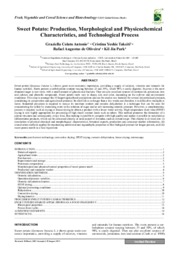Sweet potato: production, morphological and physicochemical characteristics, and technological process.
Sweet potato: production, morphological and physicochemical characteristics, and technological process.
Author(s): ANTONIO, G. C.; TAKEITI, C. Y.; OLIVEIRA, R. A. de; PARK, K. J.
Summary: Sweet potato (Ipomoea batatas L.) shows great socio-economic importance, providing a supply of calories, vitamins and minerals for human nutrition. Roots present a carbohydrate content varying between 25 and 30%, which 98% is easily digested. Sucrose is the most abundant sugar in raw roots, with a small amount of glucose and fructose. They are also excellent sources of carotenoids, potassium, iron and calcium and phenolic compounds. Sweet potato roots vary in shape, size and color, depending on the cultivar and environment conditions. This crop is amongst the 15 largest agricultural productions and can be used as raw material for several industrialized products, considering its composition and agricultural potential. Its shelf life is no longer than a few weeks and therefore it is difficult to stockpile in farms. Industrial processes is required to reduce its moisture content and osmotic dehydration is a technique that can be used for concentrating the solids by immersing roots in the solution of sugar and/or salt increasing osmotic pressure. However, a complementary process is required such as drying or freeze-drying to obtain a product with a lower water activity. High temperature short time (HTST) drying is also highly appropriate for processing of high starch content foods such as tubers. This method promotes the formation of a porous structure and consequently crispy food, thus making it possible to compete with high quality and makes it possible to industrialize differentiated products, which can be consumed directly or used as part of formulas, such as instant soups. This chapter is divided into: (i) description of physical-chemical and morphological characteristics, botanical aspects, production and consumer market information, (ii) conservation methods applied for maintaining nutritional and organoleptic properties of this biological product for longer periods, and (iii) sweet potato starch as a food ingredient.
Publication year: 2011
Types of publication: Journal article
Unit: Embrapa Food Technology
Keywords: Batata Doce, Tecnologia pós-colheita
Observation
Some of Embrapa's publications are published as ePub files. To read them, use or download one of the following free software options to your computer or mobile device. Android: Google Play Books; IOS: iBooks; Windows and Linux: Calibre.
Access other publications
Access the Agricultural Research Database (BDPA) to consult Embrapa's full library collection and records.
Visit Embrapa Bookstore to purchase books and other publications sold by Embrapa.

